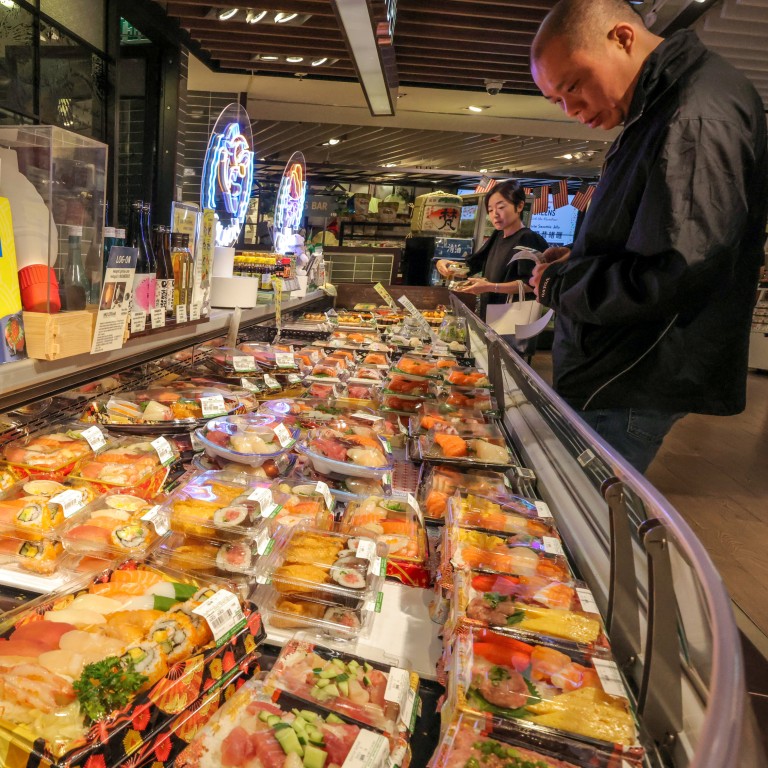
Hong Kong supermarkets, restaurants post signs stating seafood imported from Western countries as Japan starts releasing Fukushima waste water
- Wellcome tells customers its salmon came from Norway and shellfish from Canada, while labels on imported Japanese seafood at City’super list prefectures
- Japanese restaurants in the city also make efforts to reassure patrons sushi and sashimi is safe as seafood ban takes effect
At one Causeway Bay branch of the Wellcome supermarket chain, a sign displayed at the sushi section identified the different sources of the fresh seafood being sold.
The company said its salmon came from Norway, shrimp sashimi from Argentina, and sea urchin, surf clams and green whelk from Canada.

At a Causeway Bay branch of City’super, most of the raw seafood being sold was labelled by country of origin, while a sign stated that aquatic products being offered from the affected prefectures were imported before Thursday.
“Customers can shop with us with peace of mind,” the sign read.
Shoppers peered closely at the labels on boxes of sashimi and sushi, but most approached by the Post said they had confidence in the testing the Hong Kong government would carry out on Japanese food imports.
“I think the government has chosen to be more conservative for the good of public health, and I believe that any seafood they allow on the market is safe,” said Angel Tai, a teacher in her 40s. “But from now on, I will pay closer attention and be more aware of where my food is sourced from.”
Hong Kong to ban Japanese seafood from 10 prefectures over Fukushima plan
At the Genki Sushi restaurant in the Domain shopping centre in Yau Tong, one of the chain’s 74 outlets in Hong Kong, stickers informed patrons that the salmon served came from Norway.
Sushi Express, which has 35 outlets citywide, published a statement on its social media page saying its restaurants did not use any products from the 10 prefectures.
At Okonomi Japanese Food, which has been serving sushi for more than two decades, the owner said she was hit with a surge of patrons ordering sashimi on Wednesday night.
“The lunch crowd today was just slightly quieter than usual, but we need to wait and see the actual impact of this waste water incident. Although we sell sashimi, the majority of our products, including salmon, do not come from Japan,” she said.
“But diners have that misconception and associate all sashimi dishes with Japan, so we will take a hit, probably for a few months.”
She said that she planned to put up posters in the restaurant detailing the origin of the fresh seafood sold.
According to the report published by the Agriculture, Fisheries and Conservation Department, as of Thursday noon, all 50 food samples from local fish culture zones and wholesale markets passed radiation tests.
The Centre for Food Safety said all six samples of aquatic products, meat and other foods it had tested as of noon were satisfactory.
Hong Kong is Japan’s second-largest market for fisheries exports, with mainland China being the largest. In 2022, the city imported Japanese seafood products worth about 75.5 billion yen (US$536 million), accounting for more than 20 per cent of the country’s total marine product exports, government data showed.
The ban on Japanese seafood covers live, frozen, chilled, dried and preserved goods, seaweed products and sea salt from Tokyo, Fukushima, Chiba, Tochigi, Ibaraki, Gunma, Miyagi, Niigata, Nagano and Saitama.
Authorities have not specified the duration of the ban.
A look at Hong Kong’s response to the Fukushima waste water discharge plan
Tokyo plans to release 1.32 million metric tonnes, equivalent to 500 Olympic swimming pools, of the water over 30 years, sparking concerns over the safety of the ocean food chain in the region.
Lawmaker Chan Hoi-yan, who chairs the food safety and environmental hygiene panel in the Legislative Council, urged the city government to consider requiring greater detail on food labels for Japanese food imports.
“We don’t know whether the product has been transferred inside Japan and if it has been labelled as ‘from Hokkaido’ to dodge our checks,” she told a radio programme. “The government could raise its requirements for food labels besides carrying out more checks, to indicate the place of catch or transfer ports.”


